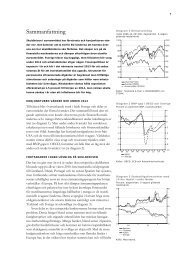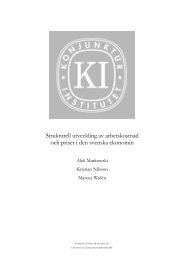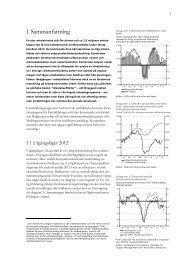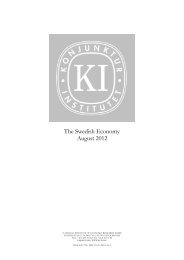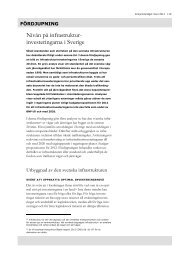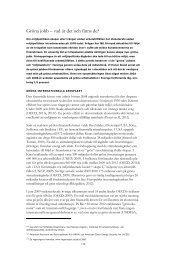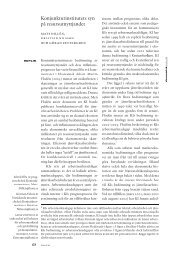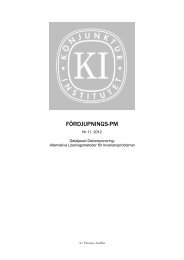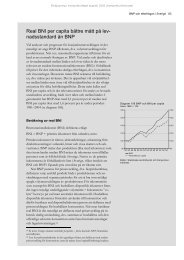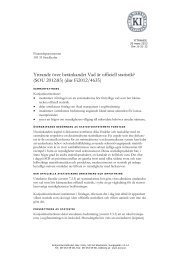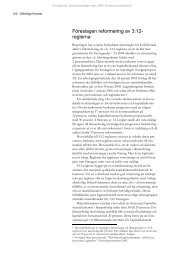Central Bank Forecasts of Policy Interest Rates - Konjunkturinstitutet
Central Bank Forecasts of Policy Interest Rates - Konjunkturinstitutet
Central Bank Forecasts of Policy Interest Rates - Konjunkturinstitutet
Create successful ePaper yourself
Turn your PDF publications into a flip-book with our unique Google optimized e-Paper software.
Working PaperNo. 128. Januari 2013<strong>Central</strong> <strong>Bank</strong> <strong>Forecasts</strong><strong>of</strong> <strong>Policy</strong> <strong>Interest</strong> <strong>Rates</strong>:An Evaluation <strong>of</strong> the First YearsBy Meredith Beecheyand Pär ÖsterholmNational Institute <strong>of</strong> Economic Research
<strong>Central</strong> <strong>Bank</strong> <strong>Forecasts</strong> <strong>of</strong> <strong>Policy</strong> <strong>Interest</strong> <strong>Rates</strong>:An Evaluation <strong>of</strong> the First Years Meredith Beechey Pär Österholm We are grateful to Jesper Hansson, Göran Hjelm and seminar participants at the National Institute <strong>of</strong>Economic Research for valuable comments. The views expressed in this paper are solely the responsibility<strong>of</strong> the authors and should not be interpreted as reflecting the views <strong>of</strong> the Executive Board <strong>of</strong> SverigesRiksbank. Sveriges Riksbank, 103 37 Stockholm, Swedene-mail: meredith.beechey@riksbank.se Phone: +46 8 787 0449 National Institute <strong>of</strong> Economic Research, Box 3116, 103 62 Stockholm, Swedene-mail: par.osterholm@konj.se Phone: +46 8 453 5948WORKING PAPER NR 128, JANUARY 2013PUBLISHED BY THE NATIONAL INSTITUTE OF ECONOMIC RESEARCH (NIER)
NIER prepares analyses and forecasts <strong>of</strong> the Swedish and international economy and conductsrelated research. NIER is a government agency accountable to the Ministry <strong>of</strong> Financeand is financed largely by Swedish government funds. Like other governmentagencies, NIER has an independent status and is responsible for the assessments that itpublishes.The Working Paper series consists <strong>of</strong> publications <strong>of</strong> research reports and other detailedanalyses. The reports may concern macroeconomic issues related to the forecasts <strong>of</strong> theinstitute, research in environmental economics, or problems <strong>of</strong> economic and statisticalmethods. Some <strong>of</strong> these reports are published in their final form in this series, whereasothers are previews <strong>of</strong> articles that are subsequently published in international scholarlyjournals under the heading <strong>of</strong> Reprints. Reports in both <strong>of</strong> these series can be ordered free<strong>of</strong> charge. Most publications can also be downloaded directly from the NIER home page.KONJUNKTURINSTITUTET, KUNGSGATAN 12-14, BOX 3116, SE-103 62 STOCKHOLMTEL: +46 8 453 59 00 FAX: +46 8 453 59 80E-MAIL: KI@KONJ.SE HOMEPAGE: WWW.KONJ.SEISSN 1100-7818
AbstractIn recent years the central banks <strong>of</strong> Norway and Sweden have published their endogenouspolicy interest-rate forecasts. In this paper, we evaluate those forecasts alongsidepolicy-rate expectations inferred from market pricing. We find that for both economiesthere are only small differences in relative forecasting precision between the central bankand market-implied measures. However, both types <strong>of</strong> forecast fail tests for unbiasednessand efficiency at longer horizons.JEL Classification: E52Keywords: Monetary policy, Market expectations, Norges <strong>Bank</strong>, Sveriges Riksbank
Summary in SwedishPå senare år har centralbankerna i Norge och Sverige publicerat sina endogena styrränteprognoser.I denna studie utvärderar vi dessa prognoser tillsammans med styrränteförväntningarberäknade utifrån marknadsprissättningen. Vi finner att det är små skillnader iprognosprecision mellan centralbanken och marknadsbaserade mått i såväl Norge somSverige. Resultaten visar även att såväl centralbankernas prognoser som styrränteförväntningarberäknade utifrån marknadsprissättningen är behäftade med frånvaro av förväntningsriktighetoch ineffektivitet på längre horisonter.
5Contents1. Introduction ................................................................................................................................................... 72. Data ................................................................................................................................................................. 83. Empirical analysis .......................................................................................................................................... 93.1 Unbiasedness and efficiency ................................................................................................................. 93.2 Forecast accuracy .................................................................................................................................. 124. Conclusions .................................................................................................................................................. 14References ......................................................................................................................................................... 16Appendix ........................................................................................................................................................... 18
71. Introduction<strong>Central</strong> bank transparency has increased dramatically over the last two decades as inflation targetinghas become a standard framework for monetary policy. The benefits <strong>of</strong> an open and transparentmonetary-policy process are widely agreed upon by policymakers and academics and have led toexplicit numerical targets for inflation, publication <strong>of</strong> minutes from policy-decision meetings andcomprehensive monetary policy reports containing forecasts <strong>of</strong> a large number <strong>of</strong> variables anddetailed descriptions <strong>of</strong> the analysis behind them.One <strong>of</strong> the more recent aspects <strong>of</strong> the increasing transparency is central banks publishing their ownforecasts <strong>of</strong> the policy interest rate. This is by no means uncontroversial and a lively discussion hasarisen about the associated costs and benefits and ultimately the limits to transparency; see, forexample, Morris and Shin (2002), Mishkin (2004), Svensson (2006), Blinder et al. (2008), Rudebusch(2008), van der Cruijsen et al. (2010) and Ehrmann et al. (2012). Proponents argue that publishingthe policy-rate path helps economic agents better understand monetary policy and lends the centralbank more influence over longer-term interest rates, thereby improving the central bank’s ability toachieve its macroeconomic objectives. Opponents argue that the policy rate path is too uncertain tobe worth communicating and point to a risk that the path might be misinterpreted as commitment.While there is no consensus, some academic research suggests that it might be beneficial to publishthe path. For example, Rudebusch and Williams (2008) show – using a small theoretical model withprivate sector imperfect information – that it generally generates better aligned expectations andhelps the central bank to achieve its goals.With the benefits uncertain, few central banks have so far chosen to publish a forecast for the policyrates. There is accordingly yet little data to analyse regarding questions relating to this issue.However, Norges <strong>Bank</strong> and Sveriges Riksbank took the step early; the former started publishing itsown policy rate forecast in October 2005 and the latter followed in February 2007. 1The purpose <strong>of</strong> this paper is to evaluate the forecasting properties <strong>of</strong> policy interest-rate forecasts<strong>of</strong> the central banks <strong>of</strong> Norway and Sweden, alongside policy-rate expectations inferred from financialmarket pricing. We evaluate unbiasedness, efficiency and precision using a standard framework.This analysis provides relevant information on a number <strong>of</strong> issues. <strong>Central</strong> banks’ forecasts andmarket expectations diverge at times, creating a tension between outlooks. 2 The divergence canowe to measurement problems when extracting market expectations from interest rates on finan-1 It should be noted that the Reserve <strong>Bank</strong> <strong>of</strong> New Zealand was the true pioneer when it comes to endogenous interestrateforecasts but it provides a forecast <strong>of</strong> the 90-day bank bill rate, not its own policy rate (the OCR rate).2 For example, Figure A1 in the appendix shows the Riksbank’s repo rate forecasts and market expectations in Swedenin October 2010 as presented in the Monetary <strong>Policy</strong> Report October 2010.
8cial-market instruments but may also reflect different outlooks about the economy and policy rate.That is, at times the central bank’s policy-rate path may not be fully credible. When the forecastpaths do diverge, one can ask which will prove to be the better forecast and on which path economicagents would do best to rely. At any given time, the answer to those questions will dependon a range <strong>of</strong> factors but this paper aims to present some facts from the realised sample so far. Ourresults show that neither the central banks’ forecasts nor market expectations pass simple tests forunbiasedness and efficiency but that there are generally very small differences in forecasting precisionbetween central banks and market expectations.The rest <strong>of</strong> this paper is organised as follows. In Section 2, we describe the data used. Section 3presents the empirical analysis and, finally, Section 4 concludes.2. DataNorges <strong>Bank</strong>’s forecasts <strong>of</strong> the sight deposit rate are those published in the Inflation Report or Monetary<strong>Policy</strong> Report from October 2005 to June 2012. 3 Similarly, Sveriges Riksbank’s forecasts <strong>of</strong> therepo rate are those published in the Monetary <strong>Policy</strong> Report and Monetary <strong>Policy</strong> Update from February2007 to July 2012. Data on market expectations inferred from financial market data were providedby Norges <strong>Bank</strong> and Sveriges Riksbank.In our empirical analysis, we focus on forecast performance at three different horizons: one quarter,one year and two years. Figures A2 to A4 in the appendix show the forecast errors – defined as , where it his the policy rate at time t h and it h|tis the forecast made ateth| tith ith | ttime t – at the different horizons in Norway. Figures A5 to A7 in the appendix show the correspondingforecast errors in Sweden.Figure 1 shows the policy interest rates in Norway and Sweden from January 2005 to September2012. As can be seen, the sample employed for our evaluation includes the tightening phase whichended in late 2008, the dramatic cuts <strong>of</strong> late 2008 and early 2009 and the period <strong>of</strong> very low rateswhich ensued.3 Norges <strong>Bank</strong> changed the name <strong>of</strong> their main report from Inflation Report to Monetary <strong>Policy</strong> Report in 2007.
9Figure 1. <strong>Policy</strong> interest rates in Norway and Sweden.3. Empirical analysisOur empirical analysis is divided into two parts. First, we test for unbiasedness and efficiency. Second,we assess the forecast precision <strong>of</strong> the different forecasts and expectations. The frameworkemployed is standard in the forecast evaluation literature; see, for example, Mehra (2002), Mankiw etal. (2003), Baghestani (2008) and Jonsson and Österholm (2011).3.1 Unbiasedness and efficiencyWe first test for unbiasedness, that is, whether the forecast errors have a zero mean. Results areshown in Table 1. For the available samples, all forecasts at all horizons have on average overpredictedthe policy-rate outcome in both countries. The extent <strong>of</strong> the over-prediction is larger inSweden at one- and two-year horizons and owes in part to the very low interest rates that prevailedduring 2009 and 2010. Having quantified the extent <strong>of</strong> the over-prediction, we ask whether it constitutesa significant bias. This is tested by running the regressioni i ,(1)tht h| tt
10whereit hand it h|tare defined as above and tis an error term. The null hypothesisH : 0 is then tested using a standard t-test. 4 As can be seen from Table 1, the null hypothesis0can be rejected at the two-year horizon for both Norges <strong>Bank</strong>’s forecasts (at the ten percent level)and the market expectations (at the five percent level). In Sweden, both the Riksbank’s forecastsand market pricing are found to have a significant bias (at conventional levels) at the two longestforecast horizons. Biased forecasts constitute a violation <strong>of</strong> rational expectations when the forecasterhas a symmetric quadratic loss function (which is a common assumption in the literature onforecast evaluations) but not necessarily so if the loss function is asymmetric. 5 In reality, the forecasters’loss function is not known, clouding an assessment <strong>of</strong> whether forecasts have been rationalover this sample. One should also keep in mind that the sample is short and contains much variationin the policy cycle. For example, forecasts and expectations at the two-year horizon in Swedenfrom 2007 and the first half <strong>of</strong> 2008 were generated by agents who were blissfully unaware <strong>of</strong> theupcoming financial crisis and who overestimated the repo rate substantially.4 Newey-West standard errors are used to address the serial correlation in the residuals.5 See, for example, Elliott et al. (2008).
11Table 1. RMSEs and results from tests <strong>of</strong> bias and efficiency.NorwaySwedenMean error Efficiency RMSE Mean error Efficiency RMSE1 quarter<strong>Central</strong> bank -0.11(0.09)-0.10(0.08)0.43 -0.14(0.10)-0.13(0.08)0.43Market pricing -0.13(0.08)-0.06(0.05)0.36 -0.08(0.11)-0.14(0.09)0.44Naive -0.13(0.23)- 0.79 -0.14(0.22)- 0.761 year<strong>Central</strong> bank -0.65(0.43)-0.55 b(0.23)1.46 -0.94 c(0.47)-0.72 a(0.19)1.74Market pricing -0.63(0.39)-0.44 b(0.23)1.36 -0.85 c(0.44)-0.66 a(0.19)1.62Naive -0.27(0.65)- 1.81 -0.52(0.61)- 1.922 years<strong>Central</strong> bank-1.37 c(0.65)-0.69 b(0.31)2.18 -2.01 a(0.63)-0.78 a(0.16)2.60Market pricing-1.41 b(0.65)-0.68 c(0.33)2.21 -1.90 a(0.62)-0.83 a(0.13)2.53Naive -0.59(0.94)- 2.41 -1.09(0.89)- 2.58Note: “Mean error” gives ˆ from equation (1). “Efficiency” gives ˆ from equation (2). a , b and c indicate significanceat the one, five and ten percent level respectively. Newey-West standard errors in parentheses ().Regressions have 22, 19 and 16 observations at the one-quarter, one-year and two-year horizons in Norway.Regressions have 31, 26 and 20 observations at the one-quarter, one-year and two-year horizons in Sweden.Next, we test for efficient use <strong>of</strong> macroeconomic data when forming expectations. A straightforwardtest <strong>of</strong> efficient use <strong>of</strong> data tests whether current information about the policy rate is systematicallyrelated to the forecast error and is based on the regressioniiit ht h | t tt, (2)where it hand it h|tare defined as above and tis an error term. As i twas in the information setat time t, efficient use <strong>of</strong> data requires that it cannot explain variation in the forecast errors. The nullhypothesis H : 0 is tested using a standard t-test (with Newey-West standard errors). Results0
12are given in Table 1. 6 At the one-quarter horizon, there are no signs <strong>of</strong> inefficient use <strong>of</strong> data ineither country. However, looking at the results for the two longest horizons, we see that both theforecasts <strong>of</strong> the central banks as well as market expectations are judged inefficient (at the five or tenpercent level in Norway and at the one percent level in Sweden). While bias is not necessarily a sign<strong>of</strong> lack <strong>of</strong> rationality, inefficient use <strong>of</strong> data is incompatible with strictly rational expectations. However,both central banks and private agents operate with incomplete information about the economyand its dynamics, making fully rational expectations perhaps an excessively demanding benchmark.3.2 Forecast accuracyAs the last step in our assessment <strong>of</strong> the policy-rate expectations, we compare the forecasting precision<strong>of</strong> the central banks’ forecasts to the expectations inferred from market pricing. Results areonce again given in Table 1.Turning to Norway, forecast errors generally are small at the one-quarter horizon. The root meansquare errors (RMSEs) for Norges <strong>Bank</strong> and market expectations are 0.43 and 0.36 respectively.Reflecting the difficulties <strong>of</strong> forecasting, absolute forecast errors are on average larger the longerthe forecast horizon. At the one-year horizon, Norges <strong>Bank</strong>’s RMSE is 1.46 and market expectations’1.36; at the two-year horizon, the corresponding numbers are 2.18 and 2.21. As can be seenfrom Figures A2, A3 and A4, both market-inferred expectations and Norges <strong>Bank</strong> over-predictedthe future policy rate substantially before the dramatic cut <strong>of</strong> December 2008. This is particularlyevident for one- and two-year ahead forecasts in which the forecast miss affects forecast errors forseveral subsequent periods. 7 The market-inferred expectations exhibit slightly higher forecast precisionthan Norges <strong>Bank</strong>’s forecasts at the two shorter horizons but the difference is small at all horizons.Naïve forecasts exhibit the largest RMSEs at all horizons.To test if there are any significant differences in forecasting performance between Norges <strong>Bank</strong> andthe alternatives we conduct a modified Diebold-Mariano test under the assumption <strong>of</strong> a quadraticloss function. 8 This is based on the regressionCB 2 alt 2e e ,t h t t h tt(3)6 We do not test for efficient use <strong>of</strong> data when it comes to the naïve forecast. It is after all a simple benchmark andshould <strong>of</strong> course be treated as such.7 Recall that by definition the forecast error <strong>of</strong> an h-step ahead forecast is serially correlated. Even an efficient forecastfor horizon h has an MA(h-1) structure.8 We use the modified test <strong>of</strong> Harvey et al. (1997) rather than the orignial one suggested by Diebold and Mariano(1995) since our samples are fairly small.
13wheree are the forecast errors <strong>of</strong> the central bank andCBt h te are the forecast errors <strong>of</strong> thealtt htalternative method we are comparing it to, that is, either market pricing or the naïve forecast; tisan error term. The null hypothesis is that the forecast accuracy <strong>of</strong> the central bank is equal to that<strong>of</strong> the alternative and is tested by comparing a transformation <strong>of</strong> the t-statistic on ˆ to the relevantcritical value from the t-distribution. Results are shown in Table 2. The null hypothesis cannotbe rejected in a single case and we hence conclude that there is no support for a difference in forecastaccuracy.Table 2. Results from modified Diebold-Mariano test.NorwaySweden1 quarterMarket pricing 0.90 -1.58Naive -1.39 -1.441 yearMarket pricing 1.29 1.72 cNaive -1.03 -0.832 yearsMarket pricing -0.13 0.64Naive -0.33 0.08Note: Entries in the table are the test statistic from the modified Diebold and Mariano test <strong>of</strong> Harvey et al.(1997). a , b and c indicate significance at the one, five and ten percent level respectively. Regressions have 22,19 and 16 observations at the one-quarter, one-year and two-year horizons in Norway. Regressions have 31,26 and 20 observations at the one-quarter, one-year and two-year horizons in Sweden.The results for Sweden show that the Riksbank has the lowest RMSE at the one-quarter horizon,albeit only marginally less than that <strong>of</strong> market-inferred expectations. At the one- and two-year horizons,the Riksbank’s forecasting performance is slightly poorer than that <strong>of</strong> market-inferred expectations;at the one-year horizon, the modified Diebold-Mariano test suggests that this difference isstatistically significant at the ten percent level. At the two-year horizon, the Riksbank also performsworse than a naïve forecast but the differences between the different measures at this horizon arequantitatively small and in no case statistically significant.Overall, there is little support for a qualitative difference between central banks’ forecasts and market-impliedexpectations <strong>of</strong> the policy rate. The forecasts follow similar patterns over time and it isevident from Figures A2 to A7 that neither the central banks nor markets foresaw the abrupt cut inpolicy rates in the immediate wake <strong>of</strong> the financial crisis.
14Both Norges <strong>Bank</strong> and the Riksbank do reasonably well relative to a naïve forecast. Norges <strong>Bank</strong>outperforms it at all horizons, as does the Riksbank at the three-month and one-year horizons.That is, central banks add information above and beyond a naïve forecast at reasonably long horizons,calling into question Goodhart and Lim’s (2011) suggestion that central banks should adopt amore mechanical approach – such as a no-change or implied forward market rate assumption – athorizons beyond two quarters. 9Goodhart and Lim’s (2011) recommendation can also be questioned on other grounds. Both a constantpolicy interest rate over the forecast horizon and implied forward market rates have been usedand later abandoned by several central banks (including Norges <strong>Bank</strong> and Sveriges Riksbank);drawbacks included difficulties in generating and interpreting the forecasts and indeterminacy inforecasting scenarios. 10 There is also intuitive theoretical appeal in the idea that communicating theoutlook aids private agents’ decision making about consumption and investment – thereby improvingthe implementation <strong>of</strong> monetary policy. Publishing endogenous interest-rate forecasts is also inline with the conclusions <strong>of</strong> Faust and Leeper (2005) and Faust and Wright (2008) that unconditionalforecasts <strong>of</strong> the policy interest rate (and goal variables) provide a more effective means <strong>of</strong>communication than conditional forecasts.4. ConclusionsThe results in this paper reveal only modest differences in forecast precision between central banks’policy-rate projections and market-implied rate expectations. From a policy point <strong>of</strong> view, this isinteresting for a number <strong>of</strong> reasons. First, it is probably comforting for proponents <strong>of</strong> endogenousinterest-rate path publications that the central bank’s forecast precision is roughly on par with themarket’s and generally superior to a naïve forecast. From that benchmark, concerns that publication<strong>of</strong> central-bank projections may prompt a deterioration in other agents’ forecasts seems unwarranted.11 Second, the relatively even forecast performance – combined with the fact that the centralbanks do fairly well compared to a naïve forecast – does not lend support for Goodhart and Lim’s(2011) recommendation that central banks should abandon their own forecasts in favour <strong>of</strong> marketimpliedexpectations or no-change forecasts. Third, when divergences do arise between the centralbank and the market-implied forecasts, the results in this paper do not give strong priors about howthe divergence will be resolved. After all, market-implied expectations have, over these samples,been as fair a guide to future developments as central-bank forecasts.9 Specifically, Goodhart and Lim (2011) evalutate short-term interest rate forecasts in New Zealand and the UnitedKingdom where the former are the forecasts <strong>of</strong> the Reserve <strong>Bank</strong> <strong>of</strong> New Zealand and the latter have been derived frommoney market yield curves. They conclude (p. 135) that the forecasts ”… have been excellent for the immediateforthcoming quarter, reasonable for the next quarter, and useless thereafter”.10 See, for example, Ólafsson (2007) for a discussion.11 Dale et al. (2011) suggest that a central bank which publishes forecasts <strong>of</strong> poor quality risks causing the privatesector’s forecast precision to deteriorate.
15However, both central-bank projections and expectations inferred from market pricing fail tests forbias and inefficiency at longer forecast horizons. This may reflect difficulties in forecasting during aturbulent period or more fundamentally, incomplete knowledge <strong>of</strong> the structure and dynamics <strong>of</strong>the economy. The results nevertheless indicate that forecasts do not live up to the demandingstandards <strong>of</strong> fully rational expectations.
16ReferencesBaghestani, H. (2008), “Federal Reserve versus Private Information: Who Is the Best UnemploymentRate Predictor?”, Journal <strong>of</strong> <strong>Policy</strong> Modeling 30, 101-110.Blinder, A., Ehrmann, M., Fratzscher, M., de Haan, J. and Jansen, D.-J. (2008), ”<strong>Central</strong> <strong>Bank</strong>Communication and Monetary <strong>Policy</strong>: A Survey <strong>of</strong> the Evidence”, Journal <strong>of</strong> Economic Literature46, 910-945.Dale, S., Orphanides, A. and Österholm, P. (2011), “Imperfect <strong>Central</strong> <strong>Bank</strong> Communication: Informationversus Distraction”, International Journal <strong>of</strong> <strong>Central</strong> <strong>Bank</strong>ing 7, 3-39.Diebold F. X. and Mariano R. S. (1995), “Comparing Predictive Accuracy”, Journal <strong>of</strong> Business andEconomic Statistics 13, 253-263.Ehrmann, M., Eijffinger, S. C. W. and Fratzscher, M. (2012), “The Role <strong>of</strong> <strong>Central</strong> <strong>Bank</strong> <strong>Forecasts</strong>for Guiding Private Sector <strong>Forecasts</strong>”, Scandinavian Journal <strong>of</strong> Economics 114, 1018-1052.Elliott, G., Komunjer, I. and Timmermann, A. (2008), “Biases in Macroeconomic <strong>Forecasts</strong>: Irrationalityor Asymmetric Loss?”, Journal <strong>of</strong> the European Economic Association 6, 122-157.Faust, J. and Leeper, E. M. (2005), “<strong>Forecasts</strong> and Inflation Reports: An Evaluation”, Paper presentedat Sveriges Riksbank’s conference Inflation targeting: implementation, communication and effectiveness,June 2005.Faust, J. and Wright, J. H. (2008), “Efficient Forecast Tests for Conditional <strong>Policy</strong> <strong>Forecasts</strong>”, Journal<strong>of</strong> Econometrics 146, 293-303.Goodhart, C. A. E. and Lim, W. B. (2011), “<strong>Interest</strong> Rate <strong>Forecasts</strong>: A Pathology”, InternationalJournal <strong>of</strong> <strong>Central</strong> <strong>Bank</strong>ing 7, 135-171.Harvey, D., Leybourne, S. and Newbold, P. (1997), “Testing the Equality <strong>of</strong> Prediction MeanSquared Errors”, International Journal <strong>of</strong> Forecasting 13, 281-291.Jonsson, T. and Österholm, P. (2011), “The Forecasting Properties <strong>of</strong> Survey-Based Wage-GrowthExpectations”, Economics Letters 113, 276-281.Mankiw, N. G., Reis, R., Wolfers, J. (2003), “Disagreements about Inflation Expectations”, NBERMacroeconomics Annual 18, 209-248.Mehra, Y. P. (2002), “Survey Measures <strong>of</strong> Expected Inflation: Revisiting the Issues <strong>of</strong> PredictiveContent and Rationality”, Federal Reserve <strong>Bank</strong> <strong>of</strong> Richmond Quarterly Review 88, 17-36.Mishkin, F. S. (2004), “Can <strong>Central</strong> <strong>Bank</strong> Transparency Go Too Far?”, In: Kent, C. and Guttman,S. (eds), The Future <strong>of</strong> Inflation Targeting, Reserve <strong>Bank</strong> <strong>of</strong> Australia, Sydney.Morris, S. and Shin, H. S. (2002), “Social Value <strong>of</strong> Public Information”, American Economic Review 92,1521-1534.Ólafsson, T. T. (2007), “Publications <strong>of</strong> Its Own <strong>Policy</strong> Rate Path Boosts the Effectiveness <strong>of</strong> <strong>Central</strong><strong>Bank</strong> Monetary <strong>Policy</strong>”, <strong>Central</strong> <strong>Bank</strong> <strong>of</strong> Iceland Monetary Bulletin 2007/1, 71-86.
17Rudebusch, G. D. (2008), “Publishing <strong>Central</strong> <strong>Bank</strong> <strong>Interest</strong> Rate <strong>Forecasts</strong>”, Federal Reserve <strong>Bank</strong> <strong>of</strong>San Francisco Economic Letter 2008-02.Rudebusch, G. D. and Williams, J. C. (2008), “Revealing the Secrets <strong>of</strong> the Temple: The Value <strong>of</strong>Publishing <strong>Central</strong> <strong>Bank</strong> <strong>Interest</strong> Rate Projections”, In: Campbell, J. Y. (ed), Asset Prices andMonetary <strong>Policy</strong>, University <strong>of</strong> Chicago Press, Chicago.Svensson, L. E. O. (2006), “Social Value <strong>of</strong> Public Information: Morris and Shin (2002) Is ActuallyPro-Transparency, Not Con”, American Economic Review 96, 448-452.Sveriges Riksbank (2010), Monetary <strong>Policy</strong> Report October 2010.van der Cruijsen, C. A. B., Eijffinger, S. C. W. and Hoogduin, L. H. (2010), “Optimal <strong>Central</strong> <strong>Bank</strong>Transparency”, Journal <strong>of</strong> International Money and Finance 29, 1482-1507.
18AppendixFigure A1. Repo rate and forecasts/expectations in Sweden.Figure A2. Forecast errors at the one-quarter horizon in Norway.Note: Date refers to when forecast was made.
19Figure A3. Forecast errors at the one-year horizon in Norway.Note: Date refers to when forecast was made.Figure A4. Forecast errors at the two-year horizon in Norway.Note: Date refers to when forecast was made.
20Figure A5. Forecast errors at the one-quarter horizon in Sweden.Note: Date refers to when forecast was made.Figure A6. Forecast errors at the one-year horizon in Sweden.Note: Date refers to when forecast was made.
21Figure A7. Forecast errors at the two-year horizon in Sweden.Note: Date refers to when forecast was made.
Titles in the Working Paper SeriesNo Author Title Year1 Warne, Anders and Current Account and Business Cycles: Stylized Facts 1989Anders Vredin for Sweden2 Östblom, Göran Change in Technical Structure <strong>of</strong> the Swedish 1989Economy3 Söderling, Paul Mamtax. A Dynamic CGE Model for Tax Reform 1989Simulations4 Kanis, Alfred and The Supply Side <strong>of</strong> the Econometric Model <strong>of</strong> the 1990Aleksander Markowski NIER5 Berg, Lennart The Financial Sector in the SNEPQ Model 19916 Ågren, Anders and Bo Consumer Attitudes, Buying Intentions and1991JonssonConsumption Expenditures. An Analysis <strong>of</strong> theSwedish Household Survey Data7 Berg, Lennart and A Quarterly Consumption Function for Sweden 1979- 1991Reinhold Bergström 19898 Öller, Lars-Erik Good Business Cycle <strong>Forecasts</strong> - A Must for 1992Stabilization Policies9 Jonsson, Bo and Forecasting Car Expenditures Using Household 1992Anders Ågren10 Löfgren, Karl-Gustaf,Bo Ranneby and SaraSjöstedtSurvey DataForecasting the Business Cycle Not Using MinimumAutocorrelation Factors11 Gerlach, Stefan Current Quarter <strong>Forecasts</strong> <strong>of</strong> Swedish GNP UsingMonthly Variables12 Bergström, Reinhold The Relationship Between Manufacturing Productionand Different Business Survey Series in Sweden13 Edlund, Per-Olov and Forecasting the Swedish Unemployment Rate: VARSune Karlsson vs. Transfer Function Modelling14 Rahiala, Markku and Business Survey Data in Forecasting the Output <strong>of</strong>Timo Teräsvirta Swedish and Finnish Metal and EngineeringIndustries: A Kalman Filter Approach15 Christ<strong>of</strong>ferson,Anders, RolandRoberts and UllaErikssonThe Relationship Between Manufacturing and VariousBTS Series in Sweden Illuminated by Frequency andComplex Demodulate Methods16 Jonsson, Bo Sample Based Proportions as Values on anIndependent Variable in a Regression Model17 Öller, Lars-Erik Eliciting Turning Point Warnings from BusinessSurveys18 Forster, Margaret M Volatility, Trading Mechanisms and InternationalCross-Listing19 Jonsson, Bo Prediction with a Linear Regression Model and Errorsin a Regressor1992199219921992199219921992199219921992
20 Gorton, Gary andRichard RosenCorporate Control, Portfolio Choice, and the Decline<strong>of</strong> <strong>Bank</strong>ing21 Gustafsson, Claes- The Index <strong>of</strong> Industrial Production – A FormalHåkan and Åke Description <strong>of</strong> the Process Behind itHolmén22 Karlsson, Tohmas A General Equilibrium Analysis <strong>of</strong> the Swedish TaxReforms 1989-199123 Jonsson, Bo Forecasting Car Expenditures Using HouseholdSurvey Data- A Comparison <strong>of</strong> Different Predictors199319931993199324 Gennotte, Gerard and Low Margins, Derivative Securitites and Volatility 1993Hayne Leland25 Boot, Arnoud W.A. Discretion in the Regulation <strong>of</strong> U.S. <strong>Bank</strong>ing 1993and Stuart I.Greenbaum26 Spiegel, Matthew and Does Round-the-Clock Trading Result in Pareto 1993Deane J. Seppi Improvements?27 Seppi, Deane J. How Important are Block Trades in the Price 1993Discovery Process?28 Glosten, Lawrence R. Equilibrium in an Electronic Open Limit Order Book 199329 Boot, Arnoud W.A., Reputation and Discretion in Financial Contracting 1993Stuart I Greenbaumand Anjan V. Thakor30a Bergström, Reinhold The Full Tricotomous Scale Compared with Net 1993Balances in Qualitative Business Survey Data –Experiences from the Swedish Business TendencySurveys30b Bergström, Reinhold Quantitative Production Series Compared with 1993Qualiative Business Survey Series for Five Sectors <strong>of</strong>the Swedish Manufacturing Industry31 Lin, Chien-Fu Jeff and Testing the Constancy <strong>of</strong> Regression Parameters 1993Timo Teräsvirta Against Continous Change32 Markowski,Aleksander andParameswarNandakumarA Long-Run Equilibrium Model for Sweden. TheTheory Behind the Long-Run Solution to theEconometric Model KOSMOS199333 Markowski,Aleksander and TonyPersson34 Kanis, Alfred andBharat Barot35 Kääntä, Pekka andChrister Tallbom36 Ohlsson, Henry andAnders VredinCapital Rental Cost and the Adjustment for theEffects <strong>of</strong> the Investment Fund System in theEconometric Model Kosmos1993On Determinants <strong>of</strong> Private Consumption in Sweden 1993Using Business Survey Data for Forecasting SwedishQuantitative Business Cycle Varable. A Kalman FilterApproachPolitical Cycles and Cyclical Policies. A New TestApproach Using Fiscal <strong>Forecasts</strong>19931993
37 Markowski,Aleksander and LarsErnsäter38 Gustafsson, Claes-Håkan39 Rahiala, Markku andTapani Kovalainen40 Öller, Lars-Erik andChrister TallbomThe Supply Side in the Econometric ModelKOSMOSOn the Consistency <strong>of</strong> Data on Production,Deliveries, and Inventories in the SwedishManufacturing IndustryModelling Wages Subject to Both ContractedIncrements and Drift by Means <strong>of</strong> a Simultaneous-Equations Model with Non-Standard Error StructureHybrid Indicators for the Swedish Economy Based onNoisy Statistical Data and the Business TendencySurvey41 Östblom, Göran A Converging Triangularization Algorithm and the 1994Intertemporal Similarity <strong>of</strong> Production Structures42a Markowski,Labour Supply, Hours Worked and Unemployment in 1994Aleksanderthe Econometric Model KOSMOS42b Markowski,Wage Rate Determination in the Econometric Model 1994AleksanderKOSMOS43 Ahlroth, S<strong>of</strong>ia, Anders The Output <strong>of</strong> the Swedish Education Sector 1994Björklund and AndersForslund44a Markowski,Private Consumption Expenditure in the Econometric 1994AleksanderModel KOSMOS44b Markowski,The Input-Output Core: Determination <strong>of</strong> Inventory 1994AleksanderInvestment and Other Business Output in theEconometric Model KOSMOS45 Bergström, Reinhold The Accuracy <strong>of</strong> the Swedish National Budget 1995<strong>Forecasts</strong> 1955-9246 Sjöö, Boo Dynamic Adjustment and Long-Run Economic 1995Stability47a Markowski,Determination <strong>of</strong> the Effective Exchange Rate in the 1995AleksanderEconometric Model KOSMOS47b Markowski,<strong>Interest</strong> Rate Determination in the Econometric 1995AleksanderModel KOSMOS48 Barot, Bharat Estimating the Effects <strong>of</strong> Wealth, <strong>Interest</strong> <strong>Rates</strong> and 1995Unemployment on Private Consumption in Sweden49 Lundvik, Petter Generational Accounting in a Small Open Economy 199650 Eriksson, Kimmo, Hierarchical Assignments: Stability and Fairness 1996Johan Karlander andLars-Erik Öller51 Url, Thomas Internationalists, Regionalists, or Eurocentrists 199652 Ruist, Erik Temporal Aggregation <strong>of</strong> an Econometric Equation 199653 Markowski,AleksanderThe Financial Block in the Econometric ModelKOSMOS19961994199419941994
54 Östblom, Göran Emissions to the Air and the Allocation <strong>of</strong> GDP: 1996Medium Term Projections for Sweden. In Conflictwith the Goals <strong>of</strong> SO 2, SO 2 and NOX Emissions forYear 200055 Koskinen, Lasse, Three Seminar Papers on Output Gap 1997AleksanderMarkowski,ParameswarNandakumar andLars-Erik Öller56 Oke, Timothy and Testing for Short Memory in a VARMA Process 1997Lars-Erik Öller57 Johansson, Anders Investment Plan Revisions and Share Price Volatility 1997and Karl-MarkusModén58 Lyhagen, Johan The Effect <strong>of</strong> Precautionary Saving on Consumption 199859 Koskinen, Lasse andLars-Erik Öllerin SwedenA Hidden Markov Model as a Dynamic BayesianClassifier, with an Application to ForecastingBusiness-Cycle Turning Points60 Kragh, Börje and K<strong>of</strong>i – a Macromodel <strong>of</strong> the Swedish Financial 1998Aleksander Markowski Markets61 Gajda, Jan B. and Model Evaluation Using Stochastic Simulations: The 1998Aleksander Markowski Case <strong>of</strong> the Econometric Model KOSMOS62 Johansson, Kerstin Exports in the Econometric Model KOSMOS 199863 Johansson, Kerstin Permanent Shocks and Spillovers: A Sectoral 1998Approach Using a Structural VAR64 Öller, Lars-Erik and Comparing the Accuracy <strong>of</strong> European GDP <strong>Forecasts</strong> 1999Bharat Barot65 Huhtala , Anni and Does International Harmonization <strong>of</strong> Environmental 1999Eva Samakovlis <strong>Policy</strong> Instruments Make Economic Sense? The Case<strong>of</strong> Paper Recycling in Europe66 Nilsson, Charlotte A Unilateral Versus a Multilateral Carbon Dioxide 1999Tax - A Numerical Analysis With The EuropeanModel GEM-E367 Braconier, Henrik and The Public Budget Balance – Fiscal Indicators and 1999Steinar Holden Cyclical Sensitivity in the Nordic Countries68 Nilsson, Kristian Alternative Measures <strong>of</strong> the Swedish Real Exchange 1999Rate69 Östblom, Göran An Environmental Medium Term Economic Model – 1999EMEC70 Johnsson, Helena and An Econometric Study <strong>of</strong> Private Consumption 1999Peter Kaplan71 Arai, Mahmood andFredrik HeymanExpenditure in SwedenPermanent and Temporary Labour: Job and WorkerFlows in Sweden 1989-199819982000
72 Öller, Lars-Erik andBharat BarotThe Accuracy <strong>of</strong> European Growth and Inflation<strong>Forecasts</strong>73 Ahlroth, S<strong>of</strong>ia Correcting Net Domestic Product for SulphurDioxide and Nitrogen Oxide Emissions:Implementation <strong>of</strong> a Theoretical Model in Practice74 Andersson, Michael Improving Fractional Integration Tests withK. And Mikael P. Bootstrap DistributionGredenh<strong>of</strong>f75 Nilsson, Charlotte and Is CO 2 Trading Always Beneficial? A CGE-ModelAnni Huhtala Analysis on Secondary Environmental Benefits76 Skånberg, Kristian Constructing a Partially Environmentally AdjustedNet Domestic Product for Sweden 1993 and 199777 Huhtala, Anni, AnnieToppinen and MattiasBoman,An Environmental Accountant's Dilemma: AreStumpage Prices Reliable Indicators <strong>of</strong> ResourceScarcity?78 Nilsson, Kristian Do Fundamentals Explain the Behavior <strong>of</strong> the Real 2002Effective Exchange Rate?79 Bharat, Barot Growth and Business Cycles for the Swedish 2002Economy80 Bharat, Barot House Prices and Housing Investment in Sweden and 2002the United Kingdom. Econometric Analysis for thePeriod 1970-199881 Hjelm, Göran Simultaneous Determination <strong>of</strong> NAIRU, Output 2003Gaps and Structural Budget Balances: SwedishEvidence82 Huhtala, Anni and Green Accounting, Air Pollution and Health 2003Eva Samalkovis83 Lindström, Tomas The Role <strong>of</strong> High-Tech Capital Formation for 2003Swedish Productivity Growth84 Hansson, Jesper, PerJansson and MårtenLöfBusiness survey data: do they help in forecasting themacro economy?200385 Boman, Mattias, AnniHuhtala, CharlotteNilsson, S<strong>of</strong>iaAhlroth, GöranBostedt, Leif Mattsonand Peichen GongApplying the Contingent Valuation Method inResource Accounting: A Bold Proposal86 Gren, Ing-Marie Monetary Green Accounting and Ecosystem Services 200387 Samakovlis, Eva, AnniHuhtala, TomBellander and MagnusSvartengrenAir Quality and Morbidity: Concentration-responseRelationships for Sweden200488 Alsterlind, Jan, AlekMarkowski andKristian NilssonModelling the Foreign Sector in a MacroeconometricModel <strong>of</strong> Sweden200020002000200020012001200489 Lindén, Johan The Labor Market in KIMOD 2004
90 Henrik Braconier, A New Method for Constructing a Cyclically Adjusted 2004Tomas Forsfält Budget Balance: the Case <strong>of</strong> Sweden91 Hansen, Sten and Is Rising Returns to Scale a Figment <strong>of</strong> Poor Data? 2004Tomas Lindström92 Hjelm, Göran When Are Fiscal Contractions Successful? Lessons for 2004Countries Within and Outside the EMU93 Östblom, Göran and Costs <strong>of</strong> Climate <strong>Policy</strong> when Pollution Affects 2004Samakovlis, Eva Health and Labour Productivity. A GeneralEquilibrium Analysis Applied to Sweden94 Forslund Johanna,Eva Samakovlis andMaria VredinJohansson95 Erlandsson Mattiasand Alek Markowski96 Östblom Göran andCharlotte Berg97 Hammar, Henrik,Tommy Lundgren andMatters Risk? The Allocation <strong>of</strong> GovernmentSubsidies for Remediation <strong>of</strong> Contaminated Sitesunder the Local Investment Programme2006The Effective Exchange Rate Index KIX - Theory 2006and PracticeThe EMEC model: Version 2.0 2006The significance <strong>of</strong> transport costs in the Swedishforest industryMagnus Sjöström98 Barot, Bharat Empirical Studies in Consumption, House Prices andthe Accuracy <strong>of</strong> European Growth and Inflation<strong>Forecasts</strong>99 Hjelm, Göran Kan arbetsmarknadens parter minskajämviktsarbetslösheten? Teori och modellsimuleringar100 Bergvall, Anders, KIMOD 1.0 Documentation <strong>of</strong> NIER´s DynamicTomas Forsfält, Macroeconomic General Equilibrium Model <strong>of</strong> theGöran Hjelm, Swedish EconomyJonny Nilsson andJuhana Vartiainen101 Östblom, Göran Nitrogen and Sulphur Outcomes <strong>of</strong> a CarbonEmissions Target Excluding Traded Allowances -102 Hammar, Henrik andÅsa LöfgrenAn Input-Output Analysis <strong>of</strong> the Swedish CaseExplaining adoption <strong>of</strong> end <strong>of</strong> pipe solutions andclean technologies – Determinants <strong>of</strong> firms’investments for reducing emissions to air in foursextors in Sweden103 Östblom, Göran andHenrik HammarOutcomes <strong>of</strong> a Swedish Kilometre Tax. An Analysis<strong>of</strong> Economic Effects and Effects on NOx Emissions104 Forsfält, Tomas, Modellansatser i <strong>Konjunkturinstitutet</strong>sJohnny Nilsson and medelfristprognoserJuhana Vartianinen105 Samakovlis, Eva How are Green National Accounts Produced inPractice?20062006200620072007200720072082008
107 Forslund, Johanna,Per Johansson, EvaSamakovlis and MariaVredin Johansson108 Forslund, JohannaEva Samakovlis, MariaVredin Johansson andLars Barregård109 Sjöström, Magnus andGöran ÖstblomCan we by time? Evaluation. Evaluation <strong>of</strong> thegovernment’s directed grant to remediation in SwedenDoes Remediation Save Lives?On the Cost <strong>of</strong> Cleaning UpArsenic-ContaminatedSites in SwedenFuture Waste Scenarios for Sweden on the Basis <strong>of</strong> aCGE-model110 Österholm, Pär The Effect on the Swedish Real Economy <strong>of</strong> the 2009Financial Crisis111 Forsfält, Tomas KIMOD 2.0 Documentation <strong>of</strong> changes in the model 2009from January 2007 to January 2009112 Österholm, Pär Improving Unemployment Rate <strong>Forecasts</strong> Using 2009Survey Data113 Österholm, Pär Unemployment and Labour-Force2009Participation in Sweden114 Jonsson, Thomas and The Properties <strong>of</strong> Survey-Based2009Pär Österholm Inflation Expectations in Sweden115 Hjelm, Göran and In Search <strong>of</strong> a Method for Measuring the Output Gap 2010Kristian Jönsson <strong>of</strong> the Swedish Economy116 Vartiainen, Juhana Interpreting Wage Bargaining Norms 2010117 Mossfeldt, Marcus and The Persistent Labour-Market Effects <strong>of</strong> the Financial 2010Pär Österholm Crisis118 Östblom, Göran,Maria LjunggrenSöderman and MagnusSjöströmAnalysing future solid waste generation – S<strong>of</strong>t linkinga model <strong>of</strong> waste management with a CGE-model forSweden2010119 Broberg, Thomas,Per-Olov Marklund ,Eva Samakovlisa andHenrik Hammar120 Gustavsson, Magnusand Pär Österholm121 Jonsson, Thomas andPär österholmDoes environmental leadership pay <strong>of</strong>f for Swed-ishindustry? - Analyzing the effects <strong>of</strong> environ-mentalinvestments on efficiencyLabor-Force Participation <strong>Rates</strong> and theInformational Value <strong>of</strong> Unemployment <strong>Rates</strong>:Evidence from Disaggregated US DataThe Forecasting Properties <strong>of</strong> Survey-Based Wage-Growth Expectations200920092009201020102010122 Antipin, Jan-Erik,Jimmy Boumedieneand Pär Österholm123 Broberg, Thomas,Tomas Forsfält andGöran ÖstblomOn the Usefulness <strong>of</strong> Constant Gain Least Squareswhen Forecasting the Unemployment RateThe Excess Cost <strong>of</strong> Supplementary Constraints inClimate <strong>Policy</strong>: The Case <strong>of</strong> Sweden’s EnergyIntensity Target20112011
124 Patrik Baard, HenrikCarlsen, KarinEdvardsson Björnbergand Maria VredinJohansson125 Hansson, Sven Ove,Karin EdvardssonBjörnberg andMaria VredinJohansson126 Antipin, Jan-Erik,Farid JimmyBoumediene and PärÖsterholm127 Meredith Beechey, PärÖsterholm128 Meredith Beechey, PärÖsterholmScenarios and Sustainability. A Swedish Case Study <strong>of</strong>Adaptation Tools for Local Decision-MakersMaking Climate <strong>Policy</strong> EfficientImplementing a Model for Environmental <strong>Policy</strong>EfficiencyForecasting Inflation Using Constant Gain LeastSquares<strong>Policy</strong> <strong>Interest</strong> Rate Expectations in Sweden: AForecast Evaluation<strong>Central</strong> <strong>Bank</strong> <strong>Forecasts</strong> <strong>of</strong> <strong>Policy</strong> <strong>Interest</strong> <strong>Rates</strong>: AnEvaluation <strong>of</strong> the First Years20112011201220122013
<strong>Konjunkturinstitutet</strong>, Kungsgatan 12-14, Box 3116, 103 62 StockholmTel: 08-453 59 00, Fax: 08-453 59 80, E-post: ki@konj.se, Webb: konj.seISSN 1100-7818



